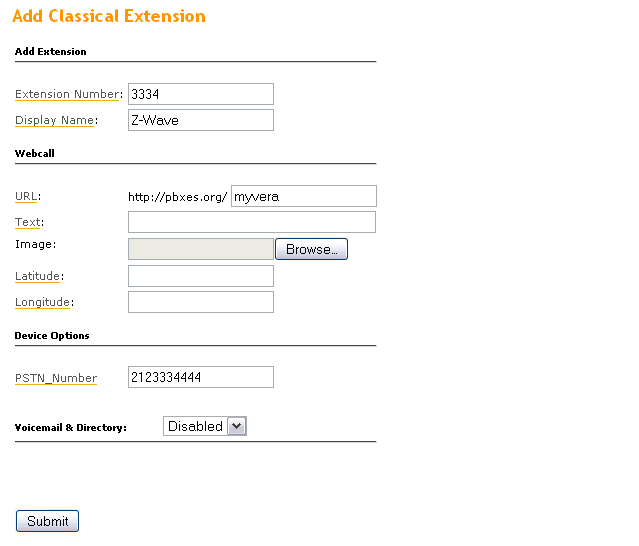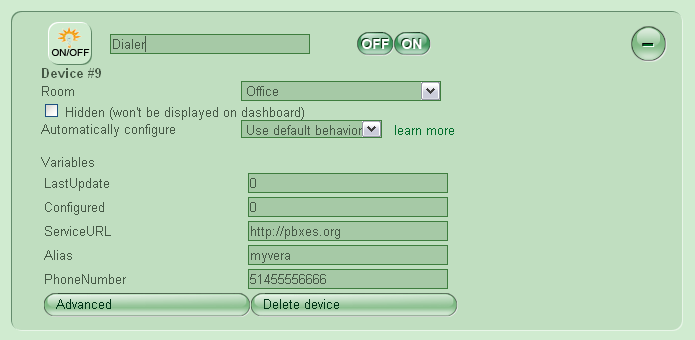Dialer Plugin
| Line 5: | Line 5: | ||
Similarly, button on z-wave controller at home could programmed to initiate a call between a speakerphone at home and your mobile or office home - which could make a sort of Quick Dial button for children or elderly ([http://thinkvoip.wordpress.com keep in mind that residential VoIP solutions are '''not designed''' to be mission critical], and thus '''should not''' be trusted for real life and death matters). | Similarly, button on z-wave controller at home could programmed to initiate a call between a speakerphone at home and your mobile or office home - which could make a sort of Quick Dial button for children or elderly ([http://thinkvoip.wordpress.com keep in mind that residential VoIP solutions are '''not designed''' to be mission critical], and thus '''should not''' be trusted for real life and death matters). | ||
| − | Before starting with the setup, user should decide on '' | + | Before starting with the setup, user should decide on ''primary'' and ''secondary'' phone numbers. Primary number is where the 'emergency' call goes (ex: user's mobile phone), secondary number is where the event happens. |
| + | To illustrate this we'll take a simplified scenario: user has an auto-answering speakerphone at home, and if something happens he wants the system to reach him on his mobile phone, connecting to the speakerphone at home so he can talk to whoever is there (at home) at the moment. In this case ''primary'' number would be the mobile phone, and the ''secondary'' number would be the home number. This is important because teh system first calls the ''primary'' number, and only when it answered it connects the ''secondary'' one. | ||
| − | * Login into your [http://pbxes.com PBXes] account, and create a Classical (or SIP if relevant) extension that would represent the '' | + | * Login into your [http://pbxes.com PBXes] account, and create a Classical (or SIP if relevant) extension that would represent the ''primary'' number as defined above. Put any unique value in URL field in Webcall section. |
[[Image:Cl-ext.png]] | [[Image:Cl-ext.png]] | ||
| Line 16: | Line 17: | ||
* Go to device settings, in field Alias put the value you used in URL @pbxes.com | * Go to device settings, in field Alias put the value you used in URL @pbxes.com | ||
| − | Fill PhoneNumber field with the '' | + | Fill PhoneNumber field with the ''secondary'' number. Don't forget to save. |
[[Image:Dealer.png]] | [[Image:Dealer.png]] | ||
| Line 23: | Line 24: | ||
* Test setup by clicking on 'On' button would trigger the call. The device can now be used in scenes, events, and Luup scripts. | * Test setup by clicking on 'On' button would trigger the call. The device can now be used in scenes, events, and Luup scripts. | ||
| − | For those who would like to go deeper: both '' | + | For those who would like to go deeper: both ''primary'' and ''secondary'' destinations can also be calling groups of various dialing strategies, or can even dial into a virtual conference rooms. |
Revision as of 03:34, 27 September 2009
Dealer Plugin allows Vera to initiate an automatic phone call between two or more parties.
For example, a motion detector at home could make Vera connect you at mobile phone and the home phone - thus letting you reach someone who just entered home immediately.
Similarly, button on z-wave controller at home could programmed to initiate a call between a speakerphone at home and your mobile or office home - which could make a sort of Quick Dial button for children or elderly (keep in mind that residential VoIP solutions are not designed to be mission critical, and thus should not be trusted for real life and death matters).
Before starting with the setup, user should decide on primary and secondary phone numbers. Primary number is where the 'emergency' call goes (ex: user's mobile phone), secondary number is where the event happens. To illustrate this we'll take a simplified scenario: user has an auto-answering speakerphone at home, and if something happens he wants the system to reach him on his mobile phone, connecting to the speakerphone at home so he can talk to whoever is there (at home) at the moment. In this case primary number would be the mobile phone, and the secondary number would be the home number. This is important because teh system first calls the primary number, and only when it answered it connects the secondary one.
- Login into your PBXes account, and create a Classical (or SIP if relevant) extension that would represent the primary number as defined above. Put any unique value in URL field in Webcall section.
- Install the plugin on Vera, create a new Dialer device, Save
- Go to device settings, in field Alias put the value you used in URL @pbxes.com
Fill PhoneNumber field with the secondary number. Don't forget to save.
- Test setup by clicking on 'On' button would trigger the call. The device can now be used in scenes, events, and Luup scripts.
For those who would like to go deeper: both primary and secondary destinations can also be calling groups of various dialing strategies, or can even dial into a virtual conference rooms.
Download Dialer plugin and enjoy!
Feel free to contact me with questions: dialer@edmidor.com

